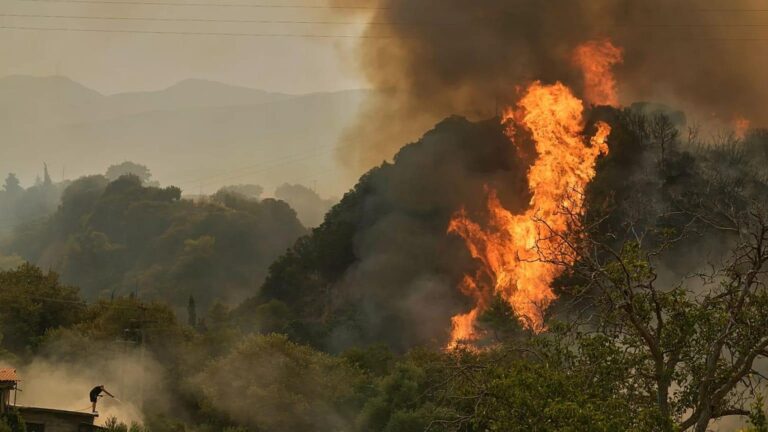Wildfires have erupted across Spain and Portugal as an intense heatwave grips the Iberian Peninsula, prompting urgent firefighting efforts and widespread evacuations. The relentless blaze has scorched thousands of hectares of forest and forced thousands of residents to flee their homes, highlighting the growing challenges posed by climate change in Southern Europe. Authorities continue to battle the flames amid soaring temperatures and dry conditions, underscoring the urgent need for coordinated responses to increasingly frequent extreme weather events.
Wildfires Devastate Vast Areas in Spain and Portugal as Temperatures Soar
Blistering heat waves have ignited a series of catastrophic wildfires across large swathes of Spain and Portugal. Authorities report that rising temperatures exceeding 40°C combined with prolonged drought conditions have created a tinderbox environment, allowing fires to spread rapidly through forested areas and rural communities. Emergency services are stretched thin as they battle to contain flames that have already consumed thousands of hectares of land, forcing widespread evacuations and disrupting local infrastructure.
Key impacts observed so far include:
- Destruction of significant wildlife habitats and agricultural land
- Multiple villages temporarily evacuated to ensure resident safety
- Intensified air pollution due to thick smoke covering urban areas
- Heightened risk of soil erosion and long-term environmental damage
Below is a summary table highlighting the most affected regions and the scale of damage reported:
| Region | Area Burned (hectares) | Evacuations | Firefighting Resources Deployed |
|---|---|---|---|
| Andalusia, Spain | 12,000 | 3,500 residents | 150 personnel, 30 aircraft |
| Castilla y León, Spain | 8,200 | 1,200 residents | 90 personnel, 20 aircraft |
| Alentejo, Portugal | 10,500 | 2,800 residents | 120 personnel, 25 aircraft |
| Central Portugal | 7,300 | 1,100 residents | 85 personnel, 18 aircraft |
Firefighters Battle Blazes Amid Prolonged Drought and Fierce Winds
In the wake of a relentless heatwave, emergency crews in Spain and Portugal have been relentlessly engaged in combating multiple wildfires that have rapidly spread across vulnerable landscapes. The combination of prolonged drought conditions and powerful gusts of wind has created a volatile environment, making containment efforts increasingly challenging. Firefighters are deploying ground teams alongside aerial support, including water-dropping helicopters and planes, to shield communities and critical infrastructure from advancing flames. Local authorities have issued evacuation orders in several high-risk zones, emphasizing safety while grappling with limited resources amid unprecedented fire activity.
Key factors exacerbating the current crisis include:
- Extended dry periods that have desiccated vegetation, turning forests into tinderboxes.
- Strong, shifting winds that amplify fire spread and unpredictability.
- Heatwaves driving temperatures well above seasonal norms, accelerating fire ignition.
| Region | Active Fires | Evacuations | Aerial Support Units |
|---|---|---|---|
| Andalusia (Spain) | 7 | 1,200+ | 6 helicopters, 3 planes |
| Alentejo (Portugal) | 5 | 800+ | 4 helicopters, 2 planes |
| Castilla-La Mancha (Spain) | 4 | 450+ | 3 helicopters, 2 planes |
Urgent Calls for Enhanced Fire Prevention Measures and Community Preparedness
Authorities and environmental experts alike are urging for immediate and sustained efforts to strengthen fire prevention strategies across vulnerable regions. The unprecedented wave of wildfires sweeping through Spain and Portugal has exposed critical gaps in existing infrastructure and emergency response protocols. Emphasis is now being placed on rigorous vegetation management, improved surveillance systems, and the integration of advanced early-warning technologies to detect fires before they escalate. Community engagement is also being prioritized, with calls for local residents to participate actively in fire safety drills and neighborhood watch programs designed specifically for wildfire risk zones.
Key community preparedness actions include:
- Creation of defensible space around homes and properties to slow down fire spread
- Regular maintenance of dry foliage and removal of combustible materials
- Clear communication channels between local authorities and residents for timely evacuation notices
- Dissemination of educational resources to raise awareness about fire hazards and safety measures
| Measure | Effectiveness | Implementation Priority |
|---|---|---|
| Early-Detection Systems | High | Urgent |
| Community Evacuation Drills | Medium | High |
| Vegetation Clearance Programs | High | Ongoing |
| Public Education Campaigns | Medium | Immediate |
In Retrospect
As wildfires continue to blaze across Spain and Portugal under relentless heatwaves, authorities face mounting challenges in containment efforts. With temperatures expected to remain high and dry conditions persisting, the risk of further outbreaks looms large. Emergency services and communities remain on high alert, emphasizing the urgent need for coordinated response and long-term strategies to mitigate the escalating threat of wildfires in the region.




